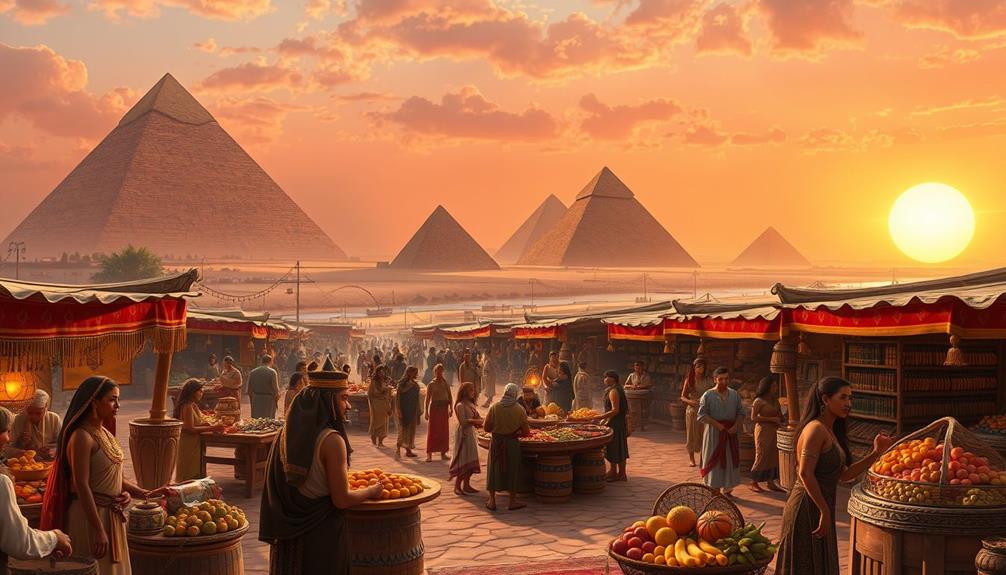Ancient Egypt is filled with fascinating tales that can surprise you. Did you know Cleopatra, often seen as a seductress, was actually a Greek queen who embraced Egyptian culture? Or that women in ancient Egypt enjoyed significant rights, including property ownership? You might be surprised to learn that the first known peace treaty occurred between Ramses II and the Hittites, showcasing their advanced diplomacy. Even leisure activities like the board game Senet reveal the culture's love for strategy. Discovering these secrets will change how you view this incredible civilization, and there's so much more to uncover just ahead.
Key Takeaways
- Cleopatra VII, though of Macedonian Greek descent, embraced Egyptian culture, speaking the language and identifying as a reincarnation of the goddess Isis.
- Women in ancient Egypt enjoyed significant legal rights, including property ownership, divorce initiation, and representation in court, reflecting their active societal roles.
- The Treaty of Kadesh, signed in 1259 B.C., is one of the earliest known peace treaties, promoting diplomacy over conflict between Egypt and the Hittites.
- Labor strikes during Ramses III's reign showcased early organized worker movements, advocating for better pay and working conditions in ancient Egypt.
- Cats were considered sacred in ancient Egypt, with strong emotional bonds to pets, leading to their mummification and legal protections against harm.
Cleopatra's True Heritage
Cleopatra VII, often shrouded in myth, was actually of Macedonian Greek descent, born into the Ptolemaic Dynasty that took control of Egypt after Alexander the Great's conquest. As the last active ruler of this dynasty, she reigned from 51 to 30 B.C., known for her sharp political acumen and her alliances with powerful Roman leaders like Julius Caesar and Mark Antony.
Her reign coincided with a time when astrology was a significant cultural element, influencing perceptions of power and allure, much like how astrological compatibility affects romantic attraction.
What sets Cleopatra apart from her predecessors is her embrace of Egyptian culture. Unlike previous rulers, she learned the Egyptian language and positioned herself not just as a ruler but as a reincarnation of the goddess Isis. This cultural integration helped her gain the loyalty of her subjects, who often viewed her as a bridge between Greek and Egyptian traditions.
Though popular culture often depicts her as a seductress, historical accounts highlight her intelligence and effective rule in a male-dominated society. Her lineage can be traced back to Ptolemy I Soter, a general of Alexander the Great, emphasizing her Greek nobility rather than native Egyptian royalty.
Understanding Cleopatra's true heritage offers a more nuanced view of this iconic figure in ancient history.
The First Peace Treaty
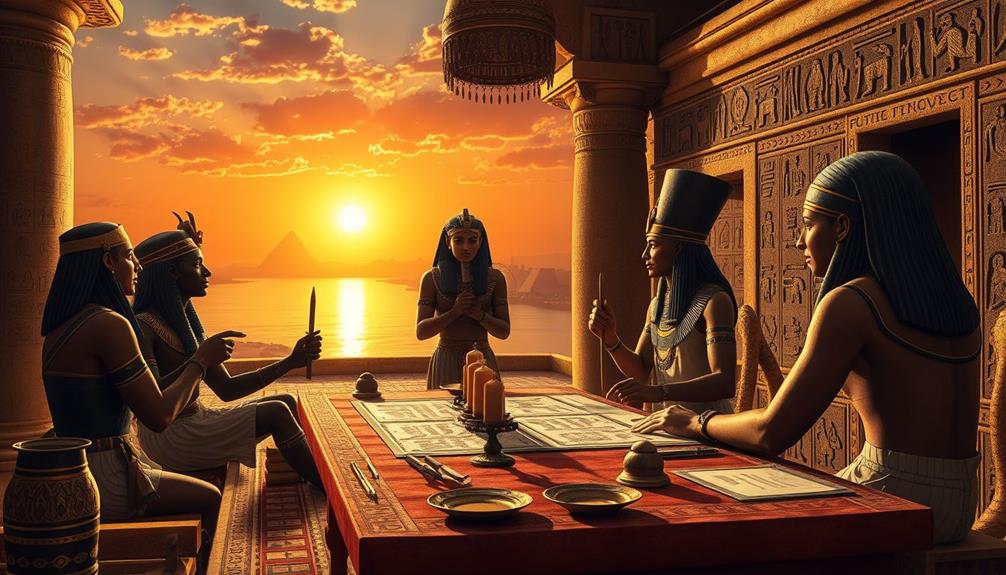
When you think about ancient diplomacy, the Treaty of Kadesh stands out as a landmark moment.
Signed around 1259 B.C. between Pharaoh Ramses II and Hittite King Hattusili III, it marked the beginning of formal diplomatic relations between two powerful nations.
This groundbreaking treaty not only ended hostilities but also laid the foundation for future alliances.
The intricacies of such agreements can be likened to steering through complex emotional relationships, where understanding and communication are key to avoiding misunderstandings and fostering cooperation, similar to the challenges faced in relationships involving BPD.
Treaty of Kadesh
Amid the backdrop of ancient warfare, the Treaty of Kadesh stands out as one of history's earliest known peace agreements, signed in 1258 B.C. between Pharaoh Ramses II of Egypt and Hittite King Hattusili III. This treaty emerged after the Battle of Kadesh, where neither side achieved a clear victory, prompting both leaders to pursue a diplomatic resolution.
The significance of this treaty can be likened to modern strategies for diversification of retirement portfolio, which aim to reduce risk through negotiation and varied investments.
The treaty was unique, written in both Egyptian and Hittite languages, and it included essential clauses for mutual defense and the return of prisoners of war. By addressing these significant issues, the Treaty of Kadesh not only ended hostilities but also set a precedent for future peace treaties.
To commemorate this landmark agreement, inscriptions and reliefs adorned temples, emphasizing its importance in promoting peace and stability in the region. The treaty laid the groundwork for diplomatic relations and influenced international relations for centuries, showcasing the power of negotiation over conflict.
For Ramses II, this treaty symbolized not just a cessation of war, but also a step towards a more interconnected world, where diplomacy could triumph over traditional warfare.
Diplomatic Relations Established
The signing of the Treaty of Kadesh marked a groundbreaking moment in the domain of diplomatic relations, establishing one of the earliest known peace treaties in history. This monumental agreement, reached around 1259 B.C. between the Egyptian pharaoh Ramses II and Hittite king Hattusili III, came after the intense Battle of Kadesh.
It wasn't just a piece of parchment; it was inscribed on a silver tablet and later recorded in hieroglyphs on temple walls, signifying its importance. The treaty's strategic implications can be compared to modern investment strategies, where diversification and mutual benefit are key, much like the diversification of retirement portfolios seen in today's financial climate.
The treaty included mutual protection clauses and stipulations for the return of prisoners, showcasing the sophisticated diplomatic negotiations of the time. Both Ramses II and Hattusili III celebrated this agreement as a victory, promoting the idea of peaceful coexistence between their two powerful nations.
This peace treaty didn't just resolve immediate conflicts; it laid the groundwork for future diplomatic relations, influencing how countries interacted for centuries to come. It's considered a foundational moment in the history of international agreements, illustrating that even in ancient times, leaders recognized the benefits of dialogue over warfare.
Board Games and Leisure
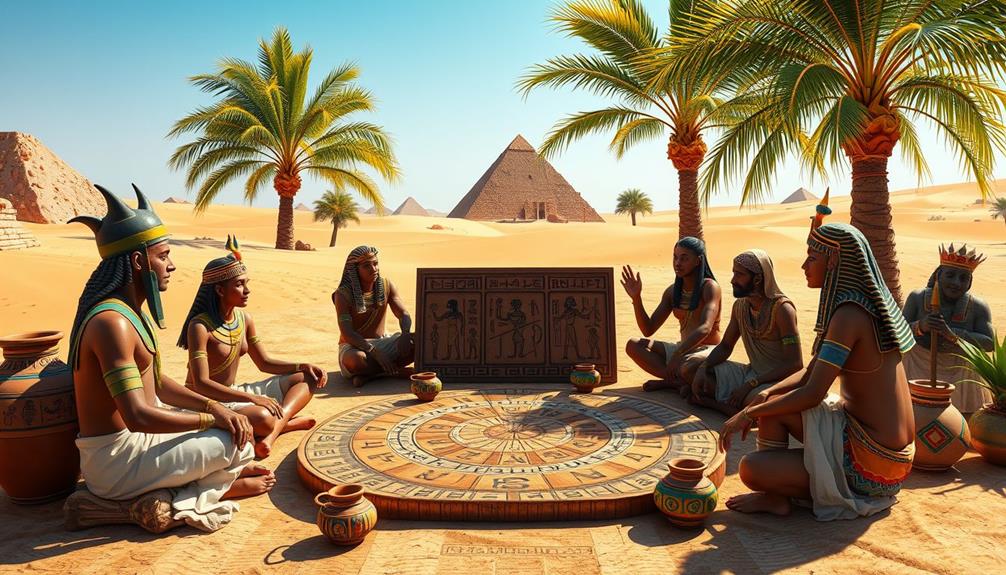
Board games played an essential role in the leisure activities of ancient Egyptians, showcasing their love for strategy and competition. One of the most popular games was Senet, dating back to around 3500 B.C. You might find it fascinating that Senet was often placed in the tombs of pharaohs, including Tutankhamun, symbolizing their journey to the afterlife.
Players moved their pieces across a 30-square board, relying on the roll of sticks or dice, adding an element of chance to the strategic gameplay. This reflects the importance of play in enhancing cognitive development and problem-solving skills, much like modern educational toys that promote learning through engagement play-based learning.
Leisure activities for ancient Egyptians extended beyond board games. They also enjoyed swimming, music, and dancing, which were embraced by both men and women. The evidence of these board games reveals a sophisticated understanding of strategy and competition within their society.
Games like Senet weren't just pastimes; they played a significant role in social gatherings and often intertwined with religious and cultural practices. By engaging in these leisure activities, ancient Egyptians fostered community bonds and expressed their cultural values.
Rights of Egyptian Women

In ancient Egypt, women enjoyed remarkable rights that set them apart from their counterparts in many other civilizations. Egyptian women had significant legal rights, allowing them to own and manage property independently, a privilege rarely granted elsewhere.
You'd find that they could initiate divorce and had legal standing in court, enabling them to represent themselves or hire legal counsel when needed.
Moreover, many Egyptian women held influential positions, with some even becoming pharaohs, like Hatshepsut and Cleopatra VII. This clearly illustrates their vital role in governance and society.
Ancient Egyptian art often depicted women in various roles, from professionals to caregivers, highlighting their active participation in both family and public life.
Education was accessible to women, which empowered them to become literate and pursue careers in fields such as weaving, medicine, and administration.
This combination of rights and opportunities allowed Egyptian women to navigate their lives with a level of autonomy uncommon in the ancient world.
Labor Strikes in Ancient Egypt

Labor strikes in ancient Egypt reveal the early emergence of organized worker movements. Documented during the reign of Ramses III in the 12th century B.C., these strikes were among the first recorded instances of labor protests.
Workers involved in constructing royal tombs, particularly in Deir el-Medina, often demanded better wages and improved living conditions due to delayed payments and insufficient rations. Curiously, such labor dynamics can be paralleled with modern practices where what to look for in a home cleaning service includes ensuring fair treatment of workers.
The artisans and laborers in this village were critical to the monumental task of building the tombs in the Valley of the Kings. When their needs went unaddressed, they resorted to strikes, showcasing their solidarity and determination.
They even utilized written complaints and inscriptions to communicate their grievances, emphasizing the importance of documentation in their fight for rights.
These labor strikes were significant enough to prompt official responses from the pharaoh, highlighting the essential role that workers played in sustaining Egypt's monumental projects.
This acknowledgment of workers' rights within society marked a pivotal moment in ancient history, indicating that even in the age of pharaohs, laborers could advocate for their needs and demand recognition.
Pharaohs and Their Weight

The fascinating world of ancient Egypt isn't just about monumental architecture and organized labor; it also includes the intriguing topic of pharaohs and their weight. Take, for instance, Pharaoh Khufu, who's famously linked to the Great Pyramid of Giza. He's estimated to have weighed around 2.5 tons (approximately 5,000 pounds) at his death, showcasing the immense wealth enjoyed by Egyptian royalty.
This wealth often created an environment where excessive self-focus and self-importance could flourish, much like traits seen in narcissistic behavior.
The weight of mummified pharaohs often surpassed that of common citizens, thanks to elaborate burial practices. Heavy sarcophagi and intricate embalming materials contributed to this added weight. Ancient texts suggest a pharaoh's diet, rich in bread, beer, and meat, influenced their heft, leading to obesity in some rulers.
In ancient beliefs, the weight of a deceased's heart was measured against the feather of Ma'at. This assessment symbolized the moral weight of their actions during life, determining their fate in the afterlife.
Additionally, the mummification process often resulted in mummies weighing up to 150 pounds more than they did when alive, due to the materials used. This fascinating interplay of weight and afterlife beliefs highlights the complex relationship between pharaohs and their physical presence in ancient Egypt.
Pyramids Built by Workers

Many people assume that the grand pyramids of ancient Egypt were constructed by slaves, but evidence tells a different story. Archaeological findings reveal that the pyramids were built by skilled laborers, including farmers, during the Nile's flood season when their agricultural work paused. This seasonal pause allowed the workers to engage in this monumental task, showcasing the impressive organization and logistical capabilities of ancient Egyptian society.
Here are some fascinating facts about the pyramids built by workers:
- The Great Pyramid of Giza, built for Pharaoh Khufu, required around 2.3 million stone blocks, weighing between 2.5 to 15 tons each.
- It's estimated that 20,000 to 30,000 workers participated in its construction, working in rotating shifts to manage the intense labor.
- Workers were provided with food, shelter, and medical care, demonstrating that they were valued members of society.
- Evidence of worker villages near the pyramids, including remains of bread and beer production, supports the idea that these builders were respected and supported.
This organization and care for workers highlight the respect and status they held in ancient Egyptian society, countering the myth of slave labor in pyramid construction.
Understanding this allows you to appreciate the massive effort behind the Great Pyramid of Giza even more.
King Tut's Mysterious Death
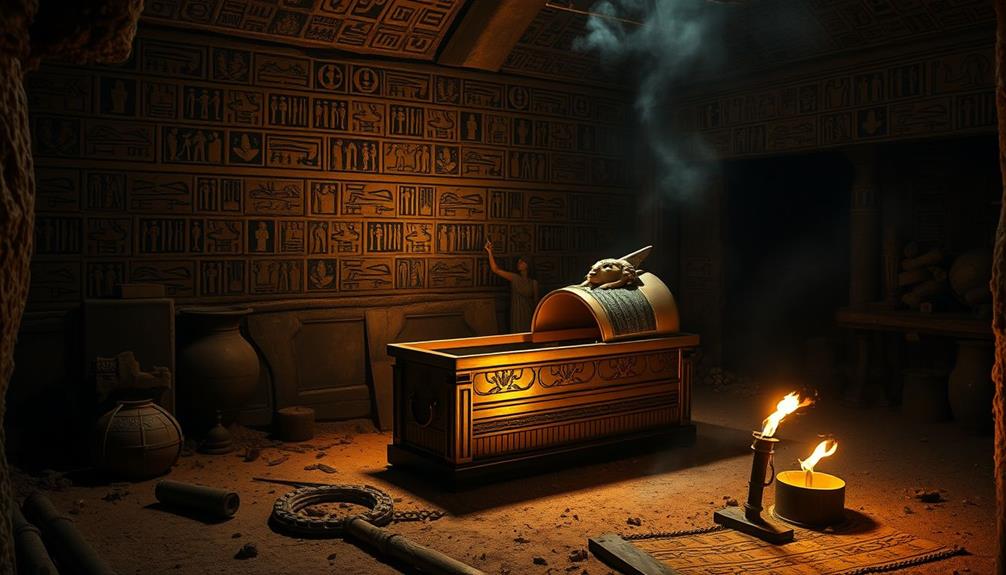
Surrounded by intrigue and speculation, King Tutankhamun's untimely death at just 19 years old remains one of ancient Egypt's most puzzling mysteries. You might find it surprising that he ascended to the throne at just nine, yet his reign ended so abruptly.
Historians debate the cause of his mysterious death, with initial examinations suggesting an infection from a broken leg. However, later studies proposed other theories, including malaria, sickle cell anemia, or even murder. Notably, some researchers have explored connections between royal health and diet, noting that foods rich in minerals, similar to those that promote strong and healthy teeth, may have been part of the ancient Egyptian diet, potentially impacting their overall health the best foods for strong teeth.
When Howard Carter discovered King Tutankhamun's tomb in 1922, he unearthed a treasure trove of artifacts that highlighted the young pharaoh's significance. Curiously, the burial practices seemed rushed, raising eyebrows about the circumstances surrounding his demise.
In 2005, CT scans revealed a possible fracture in his skull, igniting speculation that he may have suffered an accident or experienced violence before his death.
The enigma of King Tut's death continues to captivate scholars and enthusiasts alike. With ongoing research and advanced imaging techniques, you can expect fresh insights that may eventually unravel this historical puzzle.
Specialized Medical Practices
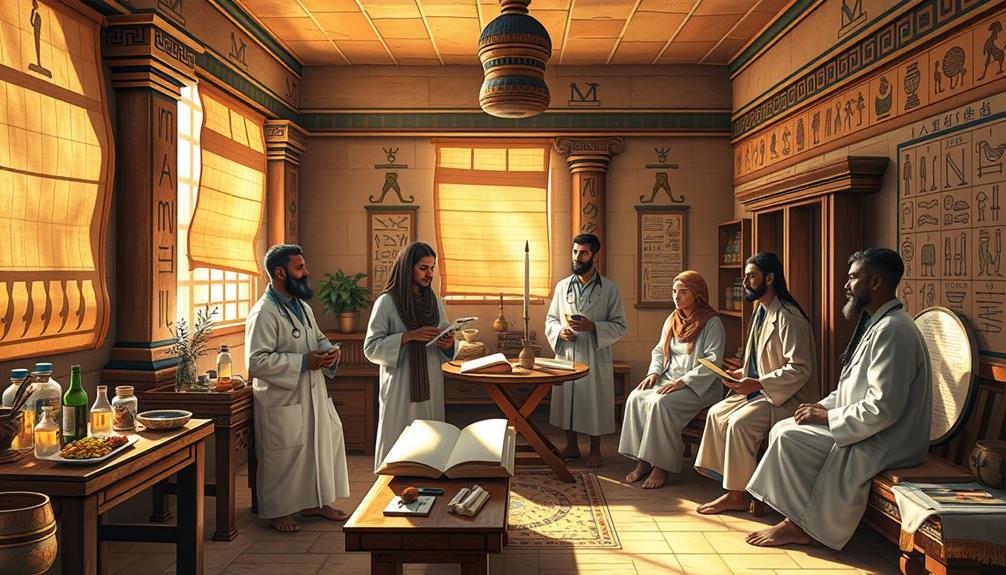
In ancient Egypt, medical practices were highly specialized, with physicians focusing on specific body parts.
For instance, they'd a deep understanding of the importance of hydration and nutrition in maintaining health, which is reminiscent of modern practices like those seen in nutrition plans to support weight loss goals.
You'd find unique titles for these practitioners, like "doctors of the tooth" for dentists.
This specialization highlights their advanced understanding of medicine during that era.
Early Medical Specialization
Ancient Egypt is remarkable for its early medical specialization, where physicians focused on distinct areas of practice. This ancient civilization laid the groundwork for organized medical practices that would influence future generations, similar to how AI enhances accuracy in modern medical diagnoses and treatment plans.
Ancient Egyptian physicians didn't just dabble in general medicine; they honed their skills in specific fields, showcasing their expertise.
Here are four fascinating aspects of their specialization:
- Dental Experts: Known as "doctors of the tooth," these specialists addressed oral health with remarkable techniques.
- Proctology Pioneers: The title "shepherd of the anus" highlights their focus on gastrointestinal health, a niche area of care.
- Surgical Knowledge: Medical papyri, like the Edwin Smith Papyrus, reveal sophisticated surgical practices and treatments for various ailments.
- Herbal Remedies: Ancient Egyptians utilized a variety of herbal treatments, demonstrating their deep understanding of anatomy and healing.
The presence of these specialized medical practitioners indicates a structured healthcare system, often operating in temples dedicated to healing gods like Imhotep.
This remarkable focus on specialized medical practices reflects an advanced understanding that would shape future medical traditions.
Unique Medical Titles
During the time of the pharaohs, ancient Egyptian physicians held unique titles that reflected their specialized practices, showcasing a systematized approach to medicine. The ancient Egyptians recognized the importance of focusing on specific body parts, leading to early medical specialization. For instance, a "doctor of the tooth" treated dental issues, while "shepherds of the anus" dealt with proctological concerns.
Their knowledge was documented in over 150 medical papyri, which detailed various ailments and treatments, demonstrating their advanced understanding of medicine. The physicians didn't just treat physical ailments; they often incorporated spiritual healing into their practices. They invoked deities for assistance, blending the physical and the metaphysical.
Moreover, their holistic approach to health included herbal remedies, dietary regulations, and ritualistic practices, ensuring thorough care for their patients. Surgical instruments like scalpels and forceps discovered in tombs indicate a sophisticated level of medical practice, especially in surgery and wound treatment.
This unique framework of specialized titles and practices reveals how ancient Egyptians laid the groundwork for modern medicine, combining scientific knowledge with spiritual beliefs.
Pet Ownership in Ancient Egypt

Pet ownership in ancient Egypt was a significant part of daily life, reflecting both practical needs and deep emotional bonds. Egyptians cherished their pets, especially cats, which were revered and associated with the goddess Bastet.
You'd find a variety of pets in households, and they played essential roles in society. Here are some fascinating aspects of pet ownership in ancient Egypt:
- Sacred Cats: Cats were so highly regarded that harming one was punishable by law. They were thought to bring protection and fortune.
- Companionship Across Classes: Pet ownership wasn't limited to the wealthy; people from all social classes kept animals for both practicality and affection.
- Mummification: Cats, dogs, and even baboons were often mummified and buried with their owners, symbolizing the strong emotional bond between them.
- Afterlife Beliefs: Egyptians believed pets could accompany them in the afterlife, resulting in elaborate burial practices for their beloved animals.
These practices highlight how integral pets were to daily life and spirituality in ancient Egypt, showcasing a unique blend of companionship and reverence.
Makeup and Beauty Rituals
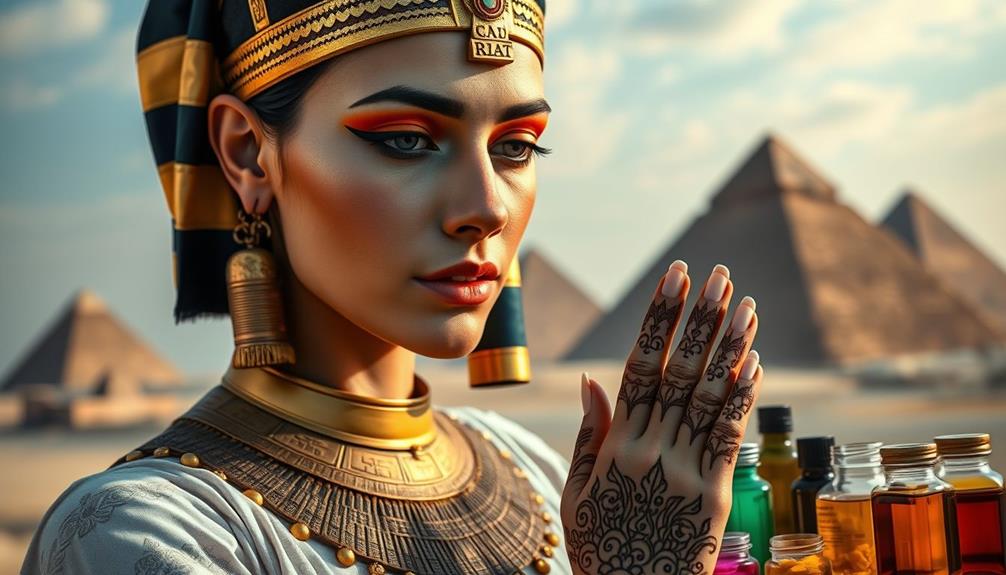
In ancient Egypt, makeup wasn't just about looking good; it played an essential role in daily life and spiritual beliefs.
You might be surprised to learn that both men and women used eye makeup made from kohl and natural pigments, which not only enhanced their appearance but also offered protection against the sun and evil spirits.
Additionally, the use of perfumes made from essential oils added a fragrant touch to their beauty rituals, highlighting the significance of aesthetics in their culture.
Eye Makeup Significance
Ancient Egyptians' fascination with eye makeup reveals much about their culture, where beauty rituals held significant meaning. For them, eye makeup was more than just an aesthetic choice; it was intertwined with their spiritual beliefs and societal norms.
Here are some key aspects of its significance:
- Protection and Health: They used kohl, a black powder made from galena, to enhance their beauty while also protecting against the sun's glare and providing antibacterial benefits.
- Social Status: Eye makeup styles varied, reflecting one's social standing and personal expression, making it an essential aspect of daily life for both men and women.
- Spiritual Significance: The application of eye makeup was believed to ward off evil spirits and was closely associated with the goddess Hathor, symbolizing protection and divine favor.
- Identity and Power: Specific colors and designs were often reserved for nobility, emphasizing the makeup's role as a symbol of identity and power within their society.
Through eye makeup, Ancient Egyptians demonstrated their intricate connection between beauty, health, and the divine, showcasing a culture rich in meaning and tradition.
Beauty Products Used
Exploring the beauty products used in Ancient Egypt reveals a sophisticated approach to personal care that combined aesthetics with practical benefits. The Egyptians made kohl, a black powder derived from galena or soot, to line their eyes. This not only enhanced their beauty but also protected against the sun's glare and warded off infections, as they believed makeup had magical healing powers.
Perfumes played a crucial role in daily life and religious rituals. Created from natural oils and fragrant flowers, these scents promoted personal hygiene and a pleasant aroma.
Henna was another key element, applied to hair and nails to achieve rich colors, showcasing individual style while holding cultural significance.
Skincare was equally important to the Egyptians. They used various oils, such as almond and sesame, to moisturize their skin and shield it from the harsh, dry climate.
Eye makeup, particularly the use of green malachite alongside black kohl, was a significant aspect of beauty rituals and served as a status symbol, with wealthier individuals often opting for more elaborate formulations.
This blend of beauty and utility reflects the depth of ancient cultures and their commitment to personal care.
The Role of Cats
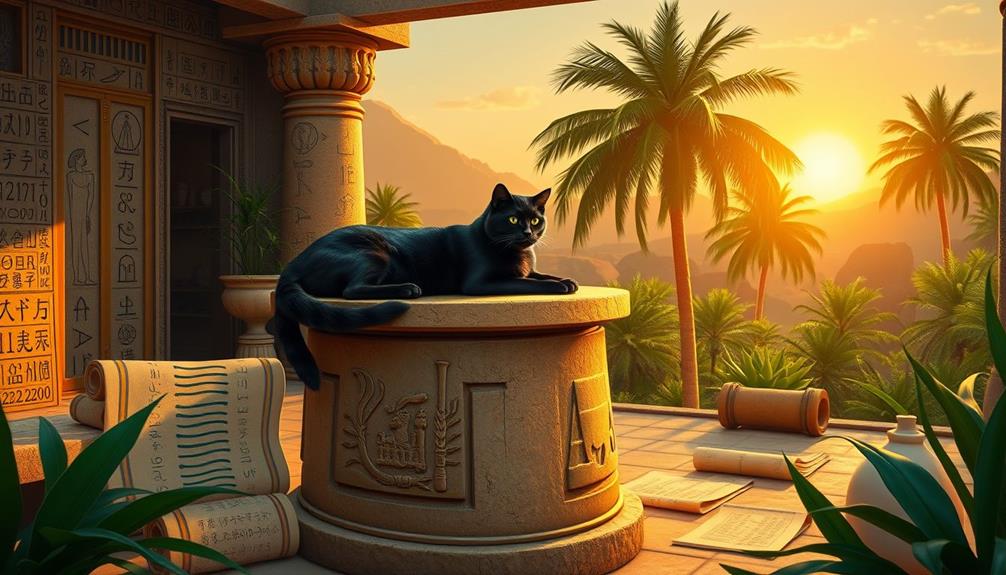
Cats held an essential place in ancient Egyptian society, serving not only as beloved pets but also as symbols of divinity and protection. The goddess Bastet, often depicted as a lioness or a woman with a cat's head, represented home, fertility, and safeguarding the household.
This reverence for cats was profound, influencing various aspects of daily life.
Here are four fascinating facts about cats in ancient Egypt:
- Killing a cat, even accidentally, was punishable by death, showcasing their sacred status.
- Egyptians domesticated cats primarily to control vermin, protecting their precious food supplies.
- Mummified cats have been discovered in large quantities in tombs, indicating their significance in burial practices and the afterlife.
- The Persian invasion of Egypt in 525 B.C. was reportedly influenced by the Egyptians' fierce protection of their cats, highlighting their cultural importance.
These facts illustrate not only how integral cats were to the Egyptians' spiritual beliefs but also their practical roles in society.
Their legacy continues today, as you might find cats still celebrated in many cultures around the world.
Hieroglyphics and Communication
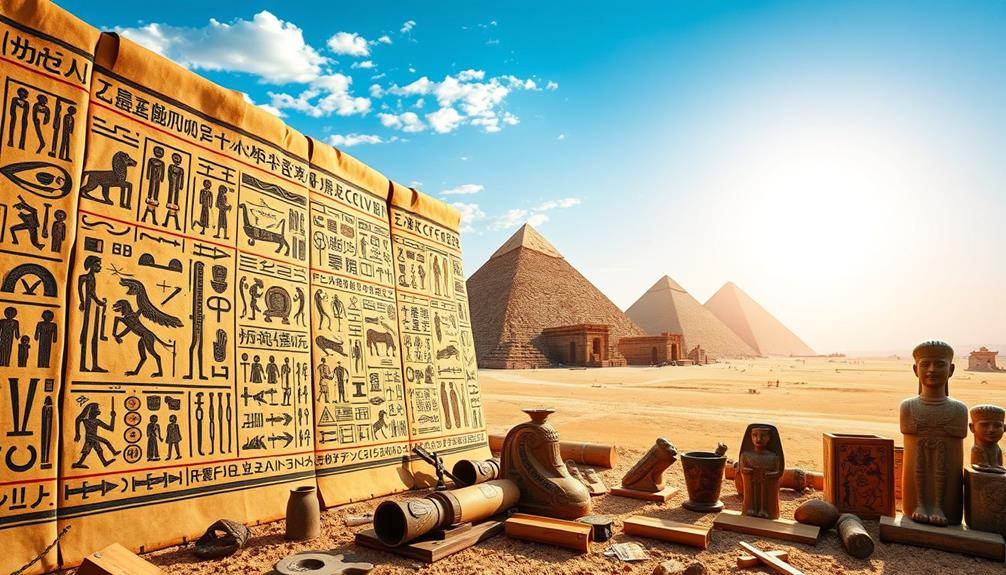
When you think about hieroglyphics, consider how this intricate writing system originated and evolved over time.
You'll find that it combines symbolic representation techniques that convey complex ideas through a rich array of images.
Scribes played a vital role in this communication, using their skills to inscribe important texts on various materials.
Origins of Hieroglyphics
The evolution of hieroglyphics represents a remarkable achievement in human communication, blending art and language into a sophisticated writing system.
Ancient Egyptians used this intricate system of over 700 symbols, combining logographic and alphabetic elements, primarily for religious texts and monumental inscriptions. The term "hieroglyphics" itself comes from Greek, meaning "sacred carving," highlighting its deep connection to temples and sacred writing.
Here are a few fascinating aspects of hieroglyphics:
- Writing Orientation: Hieroglyphics could be written in horizontal rows or vertical columns, with the symbols' direction indicating how to read them.
- Scribes: Scribes enjoyed a prestigious status in ancient Egyptian society, as literacy was scarce and they meticulously recorded events using hieroglyphics.
- The Rosetta Stone: Discovered in 1799, this artifact was vital for deciphering hieroglyphics, featuring the same text in Greek, Demotic, and hieroglyphic scripts.
- Symbolic Complexity: The system's complexity allowed for rich expression, fundamental for recording the culture and beliefs of the ancient Egyptians.
Understanding the origins of hieroglyphics reveals the brilliance of early human communication.
Symbolic Representation Techniques
Often, ancient Egyptians used symbolic representation techniques in their hieroglyphics to convey complex ideas and emotions effectively. This writing system boasted over 700 symbols, combining logographic and alphabetic elements that made it rich and versatile.
Hieroglyphics served various purposes: from religious texts to official record-keeping, showcasing the sophistication of ancient Egyptian communication.
The Rosetta Stone played a pivotal role in deciphering hieroglyphics, revealing both the phonetic and symbolic components of this intricate language. While scribes primarily utilized these symbols, their high status in society stemmed from their literacy and documentation skills.
You'd find hieroglyphics not only in formal writing but also integrated into art, adorning temples and tombs with inscriptions that narrated religious and historical tales.
The complexity of hieroglyphics allowed ancient Egyptians to embed layers of meaning within their symbols, reflecting their advanced understanding of communication.
When you look at these symbols today, you see more than just writing; you witness a civilization that mastered symbolic representation, leaving behind a legacy of rich narratives and profound cultural significance.
Role of Scribes
Scribes played an essential role in ancient Egyptian society, acting as the primary bearers of literacy and communication. Their skills in hieroglyphics made them fundamental for governance, record-keeping, and the preservation of ancient Egyptian culture.
Here are some fascinating aspects of their role:
- Prestigious Status: Scribes held high esteem, often working closely with pharaohs and officials.
- Complex Writing System: Hieroglyphics comprised over 700 symbols, blending logographic and alphabetic elements for intricate communication.
- Educational Foundations: They were trained from a young age in "houses of life," mastering the art of writing on papyrus with reed pens and natural ink.
- Cultural Preservation: Their documentation efforts helped maintain the knowledge and literature of ancient Egyptian culture throughout history.
The discovery of the Rosetta Stone in 1799 was significant, featuring hieroglyphics alongside Demotic and Greek scripts.
It aided in deciphering hieroglyphics and revealing the mysteries of ancient Egyptian language.
Daily Life and Culture
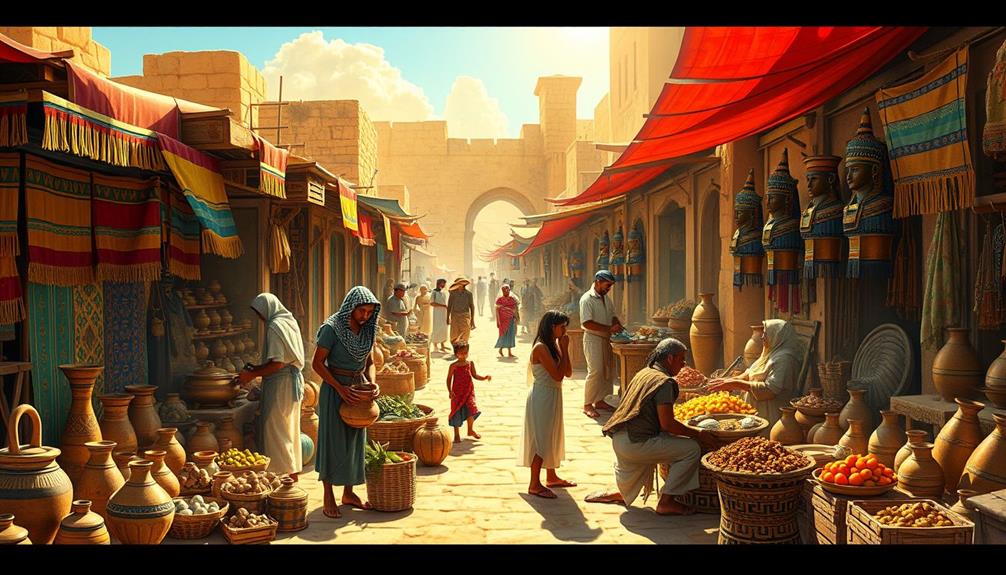
Daily life in ancient Egypt revolved around a blend of agriculture, religion, and community. Most Egyptians were farmers, living in mud-brick houses and relying on the Nile's annual floods to enrich their soil. Families kept pets, especially cats, which were valued for companionship and pest control. Both men and women embraced makeup for beauty and protection against the sun.
Here's a quick look at some aspects of daily life:
| Aspect | Description | Examples |
|---|---|---|
| Occupation | Mainly farmers | Growing wheat, barley |
| Clothing | Simple linen garments | Tunics, kilts |
| Recreational Activities | Board games like Senet | Symbolizing afterlife |
| Family Life | Strong family bonds | Shared meals, rituals |
| Innovations | Early technology | Papyrus, locks, toothpaste |
Women had crucial roles, managing households and participating in economic activities. Recreational activities, like playing Senet, provided enjoyment and reflected beliefs about the afterlife. This rich culture shows how interconnected daily life, spirituality, and innovation were in ancient Egypt.
Major Historical Discoveries
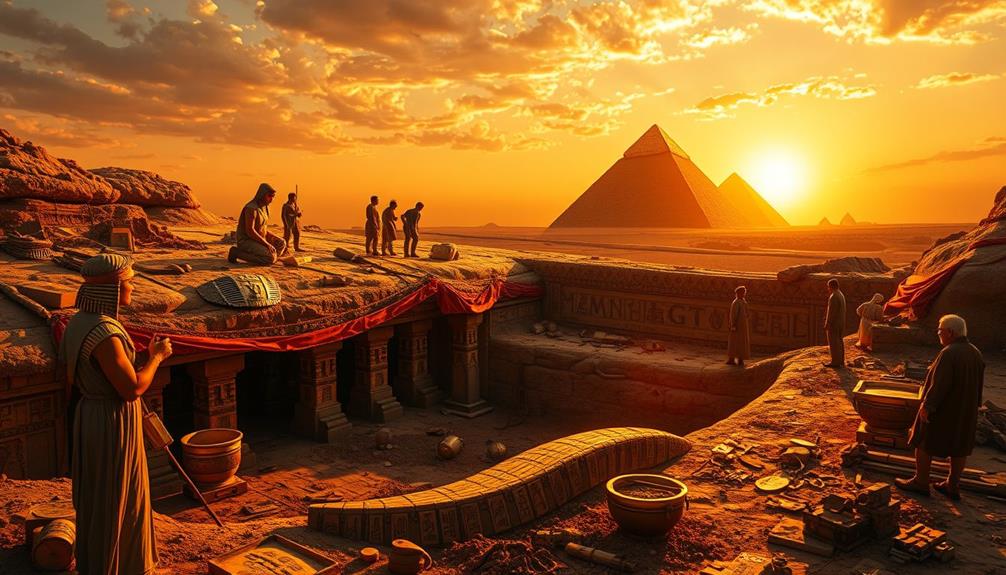
Have you ever wondered how our understanding of ancient Egypt has transformed through major archaeological discoveries? These breakthroughs have opened doors to the past, disclosing the rich tapestry of this fascinating civilization.
Here are four monumental discoveries that changed everything:
- King Tutankhamun's Tomb: Discovered in 1922 by Howard Carter, it disclosed a treasure trove of artifacts, revolutionizing our knowledge of burial practices and daily life in ancient Egypt.
- The Rosetta Stone: Found in 1799, this stone was essential for deciphering hieroglyphics, featuring inscriptions in Greek, Demotic, and hieroglyphic scripts.
- Valley of the Kings: Home to over 60 tombs, including those of Ramses II and Seti I, it showcases the intricate burial customs and beliefs of ancient Egyptian royalty.
- Tomb of Hatshepsut: This female pharaoh's tomb, also in the Valley of the Kings, highlights her significant role and contributions to ancient Egyptian history and architecture.
These discoveries continue to enrich our understanding of ancient Egypt, disclosing the complexities of its culture, politics, and daily life.
Conclusion
In exploring ancient Egypt, you've uncovered some truly remarkable facts, like how Cleopatra wasn't just a queen but also a descendant of Macedonian Greeks. Did you know that ancient Egyptians were among the first to sign a peace treaty? This fascinating pact, known as the Treaty of Kadesh, was established over 3,200 years ago between Egypt and the Hittites. These insights not only deepen your appreciation for their culture but also highlight the complexity of their society.
